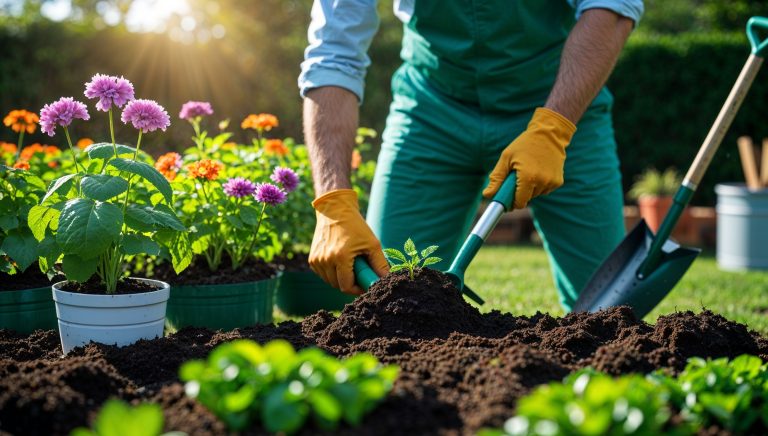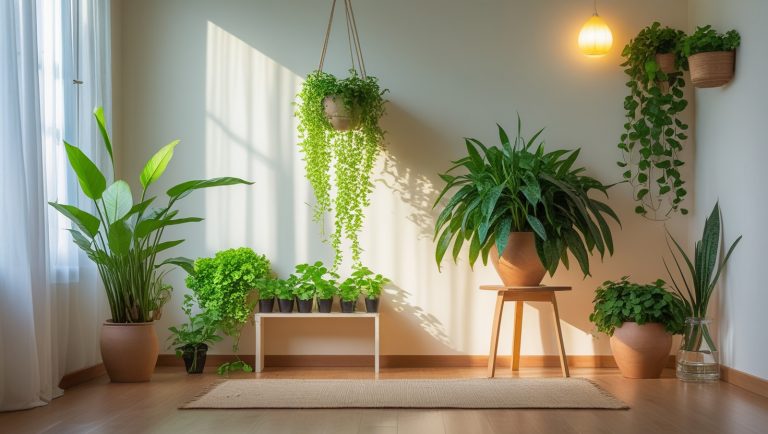

Creating a thriving indoor garden starts with understanding the space in which your plants will grow. Whether you have a small apartment or a larger house, the first step in choosing the best plants for your indoor garden is evaluating your environment. Your space’s lighting, temperature, humidity, and airflow will all affect how well plants grow.
Light is arguably the most important factor in plant growth. Indoor plants have different light needs, so it’s crucial to understand how much natural light your space receives throughout the day and which direction it comes from.
Understanding how much light your space gets is crucial in ensuring that your plants will have a happy and healthy environment.
Temperature and humidity levels play a significant role in the health of your indoor plants. Most indoor plants prefer stable temperatures that are neither too hot nor too cold, typically ranging from 60°F to 75°F (15°C to 24°C).
Placing plants near air conditioners, heating vents, or drafty windows can cause temperature fluctuations, which can stress the plants. If your indoor space has extreme temperature swings, you may want to rethink where you place your plants to ensure they get a more consistent environment. Avoid placing delicate plants near direct heat sources or cold drafts from open windows.
Humidity is another important factor. Indoor plants require different humidity levels to grow effectively. Some plants, like ferns and calatheas, thrive in high humidity, while others, such as succulents and cacti, prefer dry air. Indoor heating, particularly during winter, can make the air in your home very dry. If you live in a dry climate, or if your home tends to be dry due to heating, it’s essential to provide extra moisture to your plants.
If you have plants that thrive in higher humidity, such as tropical plants, using a humidifier or placing plants together in a cluster can help boost the moisture in the air. Another simple way to raise humidity is by placing a shallow tray filled with water and pebbles underneath your plants. As the water evaporates, it will increase the moisture level in the surrounding air.
Conversely, plants that require drier conditions, like succulents, should be placed away from any sources of extra moisture or humidity, as this can cause them to rot.
Once you have a better understanding of your indoor space’s light, temperature, and humidity, it’s time to select plants that will thrive in those conditions. Whether you’re a beginner or an experienced gardener, there are a variety of plants that can thrive in any home, regardless of experience level.
If your home doesn’t have access to much natural light, don’t worry. There are plenty of plants that are perfect for low-light conditions. These plants are resilient and can thrive even in dimly lit spaces.
For homes with moderate light, there are several beautiful plants to choose from. Medium-light spaces are perfect for a wider range of plants, as long as they don’t receive direct sunlight all day.
If you’re fortunate enough to have a home with plenty of natural light, you can grow a wide variety of plants that need full sun to thrive. These plants will do best in south- or west-facing windows where they can soak up the sunlight throughout the day.
Proper care is essential to ensuring the health and longevity of your indoor garden. Indoor plants still need sunlight, water, and nutrients, but they require less maintenance than outdoor plants. Here’s how you can care for your indoor plants and keep them thriving.
One of the most common mistakes when caring for indoor plants is overwatering. Many indoor plants are more tolerant of dry conditions than wet ones, so it’s essential to check the moisture level of the soil before watering.
The general rule of thumb is to water when the top inch of soil feels dry to the touch. You can also use a moisture meter to help you monitor the moisture levels in the soil. Be sure to use a watering can with a narrow spout to avoid getting water on the leaves, as this can cause rot.
For plants like succulents or cacti, wait until the soil is completely dry before watering again. Plants in containers can dry out quickly, so it’s essential to monitor their water needs regularly.
Fertilizing your plants helps them grow strong and healthy. Indoor plants don’t need frequent fertilizing, but they will benefit from occasional feedings. Use a balanced, water-soluble fertilizer once a month during the growing season (spring and summer). Be sure to follow the manufacturer’s instructions on the packaging to avoid over-fertilizing, which can harm the plants.
If you’re using organic fertilizers, such as compost or worm castings, you can fertilize less frequently. Organic fertilizers provide slow-release nutrients, making them ideal for plants that don’t require frequent feedings.
Pruning is essential to keep your plants looking neat and encourage new growth. Trim dead or damaged leaves regularly to promote healthy, fresh foliage. Deadheading spent flowers will encourage more blooms. For trailing plants like pothos, pruning can help encourage bushier growth and prevent them from becoming leggy.
Indoor gardening is a rewarding hobby that can transform your home into a lush, green sanctuary. By understanding your space’s lighting, temperature, and humidity levels, you can choose the best plants for your environment. Whether you’re growing low-maintenance plants like snake plants or adding colorful blooms like peace lilies, indoor gardening offers endless possibilities for enhancing your living space. With a little care and attention, your indoor garden will thrive and bring joy for years to come.